Military Robots Market Size
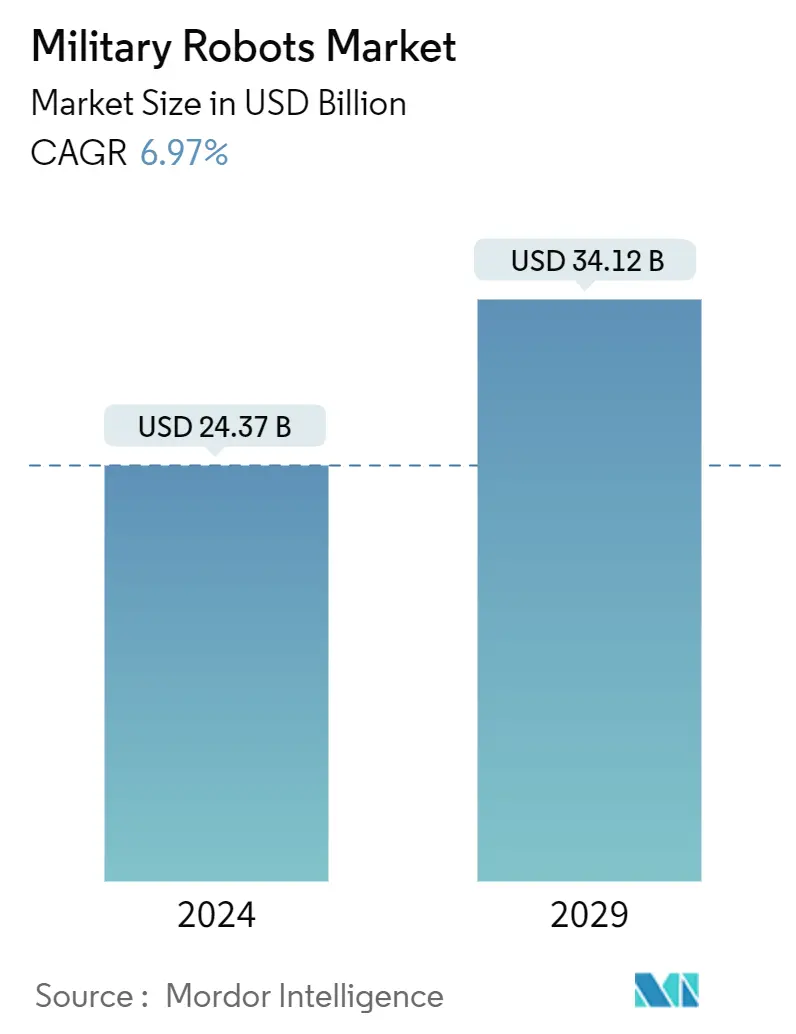
| Study Period | 2019 - 2029 |
| Market Size (2024) | USD 24.37 Billion |
| Market Size (2029) | USD 34.12 Billion |
| CAGR (2024 - 2029) | 6.97 % |
| Fastest Growing Market | Asia-Pacific |
| Largest Market | North America |
Major Players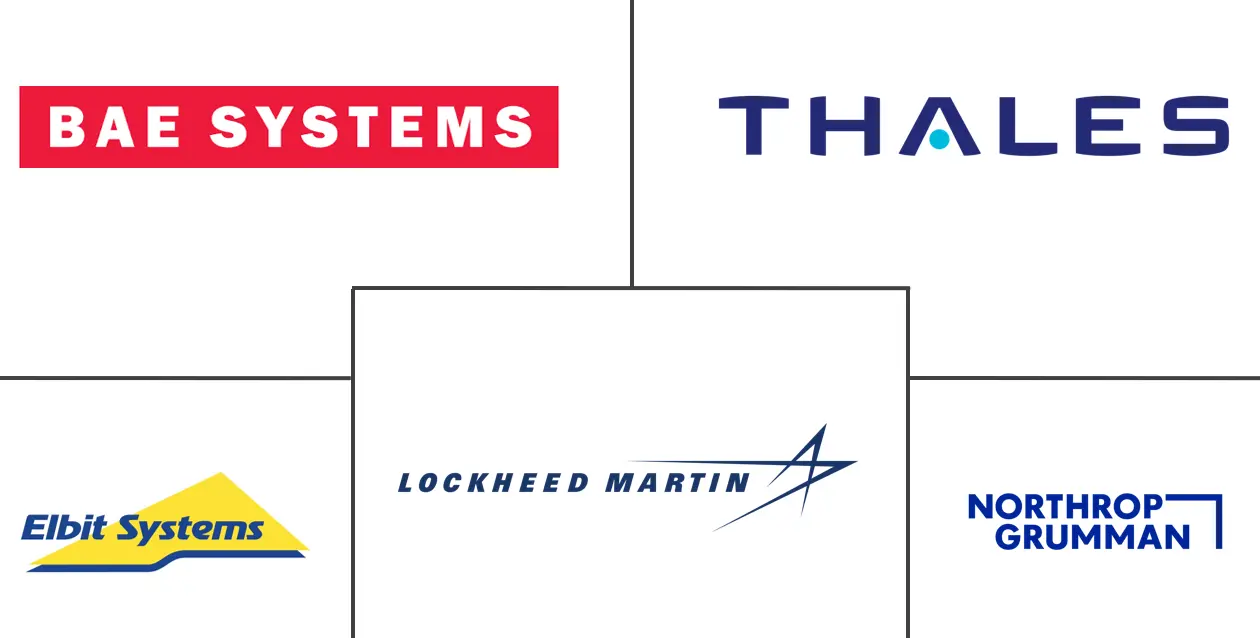
*Disclaimer: Major Players sorted in no particular order |
Military Robots Market Analysis
The Military Robots Market size is estimated at USD 24.37 billion in 2024, and is expected to reach USD 34.12 billion by 2029, growing at a CAGR of 6.97% during the forecast period (2024-2029).
- Since the demand for military robots is a direct proponent of the ongoing procurement and upgrade of the fielded armada of aerial, terrestrial, and naval platforms, it is significantly affected by the sanctioned annual defense budget of the nations. The COVID-19 pandemic had a moderate impact on the market in focus due to disruption in the defense supply chains and production outputs in 2020. However, the market has improved since then due to the streamlining of the supply chain activities, helping the growth of the military robots market.
- The changing texture of warfare and the price placed on war casualties have favored robot deployments in modern wars. Casualties in past wars have raised concern and resulted in most governments investing in new unmanned systems to maintain a fleet of UAVs, UUVs, and UGVs for critical missions.
- Countries are collaborating on advanced technologies in robotics to develop new vehicles that can overcome challenges and support ground troops for future warfare. Additionally, the major players in the industry are supported by government bodies that make substantial investments, which enables them to spend more on R&D, allowing the companies to innovate continuously and introduce more efficient and advanced technologies.
Military Robots Market Trends
Land Segment Anticipated to Generate Highest Growth During the Forecast Period
- The land segment is expected to grow with the highest CAGR during the forecast period owing to the growing military expenditure by countries globally. The land forces are deploying sophisticated military robots in situations and areas deemed too dangerous, which can easily result in the death or capability restriction of the deployed troops.
- Several countries are either testing the current feasibility of robotics in their land-based armed forces or envisioning deploying them on a large scale in the future. Mine clearance military robots are technological advancements that have transformed the dangerous task of detecting and disarming land mines. These autonomous or semi-autonomous machines employ various sensor technologies, such as ground penetrating radar, metal detectors, and thermal imaging, to identify and locate explosive devices hidden beneath the surface.
- Similarly, firefighting military robots have emerged as an essential tool in managing fire-related emergencies in military scenarios. The Modular Advanced Armed Robotic System (MAARS), developed by QinetiQ North America, represents a significant advancement in military robotics. This tracked robot is designed for reconnaissance, surveillance, and target acquisition (RSTA) and to increase the security of personnel manning forward locations. Under the Man Transportable Robotic System Increment II (MTRS Inc II), the US Army is acquiring unmanned ground vehicles to support engineers, chemical, biological, radiological, and nuclear (CBRN) soldiers, and special operations forces.
- The new UGVs are replacing the aging non-standard fleet of robots for locating, identifying, and clearing landmines, unexploded ordnance, and improvised explosive devices, which may enhance the maneuverability and survivability of military personnel.
- Similarly, Russia created its first unit of strike robots, and it has plans to integrate a variety of robots and exoskeletons. In April 2021, the Russian Defense Ministry announced the creation of a separate unit of military robots comprising five Uran-9 robotic systems. Manufactured by Kalashnikov Concern, the Uran-9 is a tracked unmanned combat ground vehicle designed to assist combat, reconnaissance, counter-terrorism units, and fire support. The 12-ton robot is integrated with Ataka-guided weapons, anti-tank missiles, Shmel-M rocket launchers, a 30mm 2A72 automatic cannon, and a 7.62mm machine gun.
- Such plans to adopt robots are expected to drive the growth prospects of the land segment of the market studied.
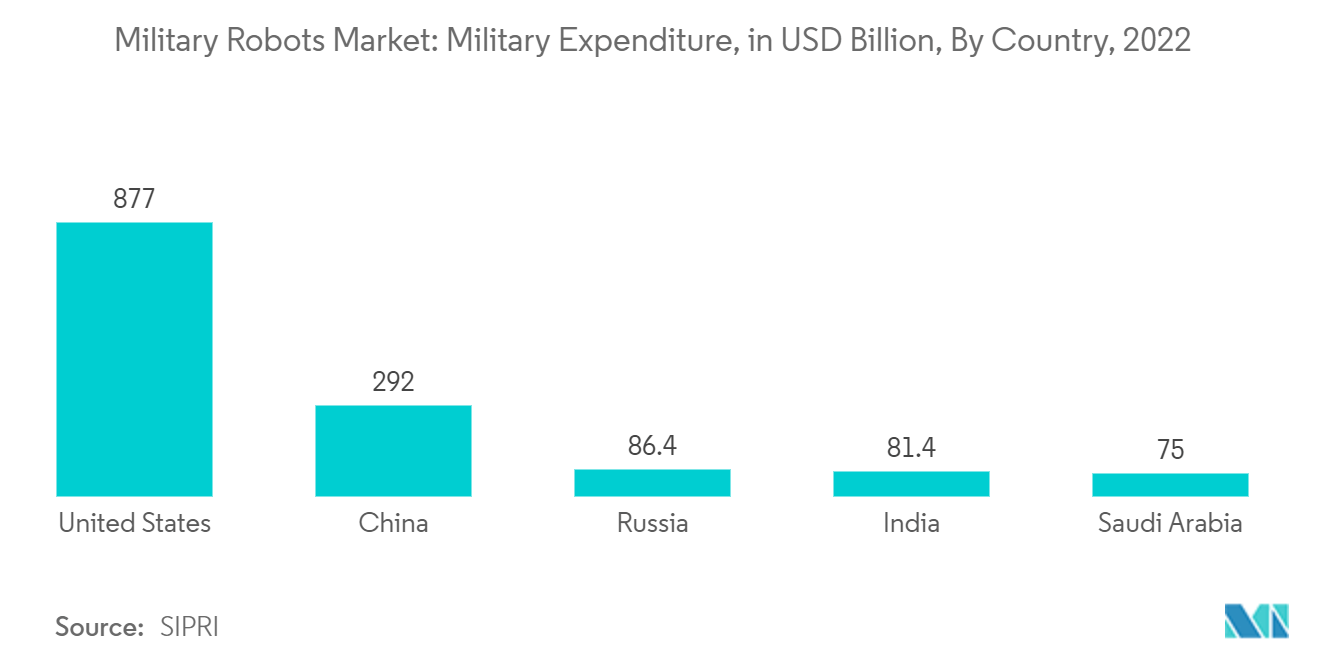
Asia-Pacific Region likely to Witness Highest Growth During the Forecast Period
- The major countries in the region, like China, India, and Japan, among others, have been rapidly increasing their defense spending in the past few years. Out of the total defense spending, the countries have significantly invested in developing and deploying unmanned systems into the armed forces that can enhance their combat and surveillance capabilities.
- For instance, South Korea's Defense Acquisition Program Administration (DAPA) announced the successful completion of the exploratory development phase for the 66 Unmanned Surveillance Vehicle in April 2021. After completing the exploratory development phase, the agency is expected to begin the full-scale development of the strike-capable platform in the coming years.
- On the other hand, in 2021, the Indian Army carried out a drone swarm technology demonstration with 75 locally designed and developed drones buzzing in the skies and simulating a raft of missions, including offensive operations. A similar trend of local manufacturing is observed in other countries of the Asia-Pacific region. In January 2022, China introduced a quadruped robot to assist the military in logistics and reconnaissance missions.
- The country claims that it is the world's largest electrically-powered robot. The four-legged robot can reportedly carry up to 352 pounds (160 kilograms) of payload and run at six miles (10 kilometers) per hour. The escalating border tensions between various neighboring countries of the Asia-Pacific region are anticipated to accelerate the growth of the military robotics market during the forecast period.
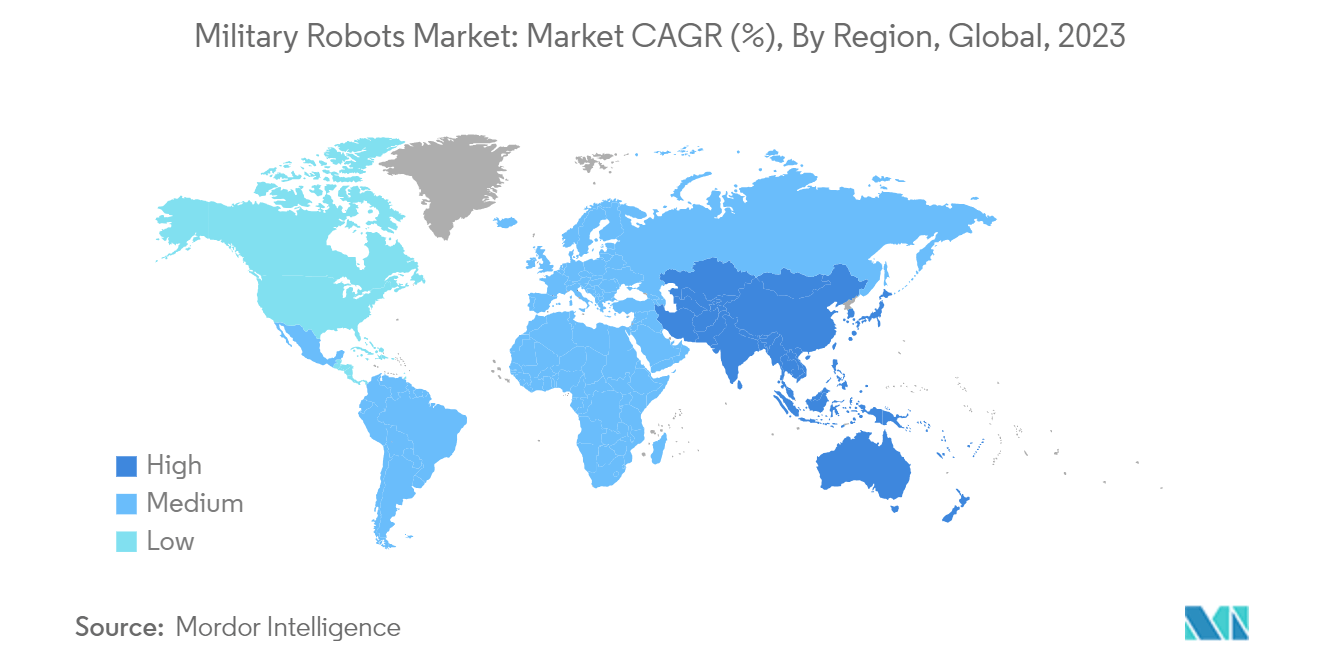
Military Robots Industry Overview
The market for military robots is fragmented due to the presence of multiple established military OEMs and technology firms. Some prominent players in the military robots market include Lockheed Martin Corporation, Northrop Grumman Corporation, THALES, Elbit Systems Ltd, and BAE Systems PLC. There are many local players in the market, such as Defence Research and Development Organisation (DRDO), Baykar, and Milrem AS, among others.
The small players funded by the government are expected to play a key role in developing and maturing the robotics technology over the next decade, while the military forces test and experience the technology's challenges, risks, and benefits and settle on key expectations and technological necessities for their equipment. Next-generation military equipment and platforms being developed by players are being observed keenly on their progress and technology development. They are expected to gain popularity and customer interest in the years to come.
Military Robots Market Leaders
-
Elbit Systems Ltd
-
BAE Systems plc
-
Northrop Grumman Corporation
-
Lockheed Martin Corporation
-
THALES
*Disclaimer: Major Players sorted in no particular order
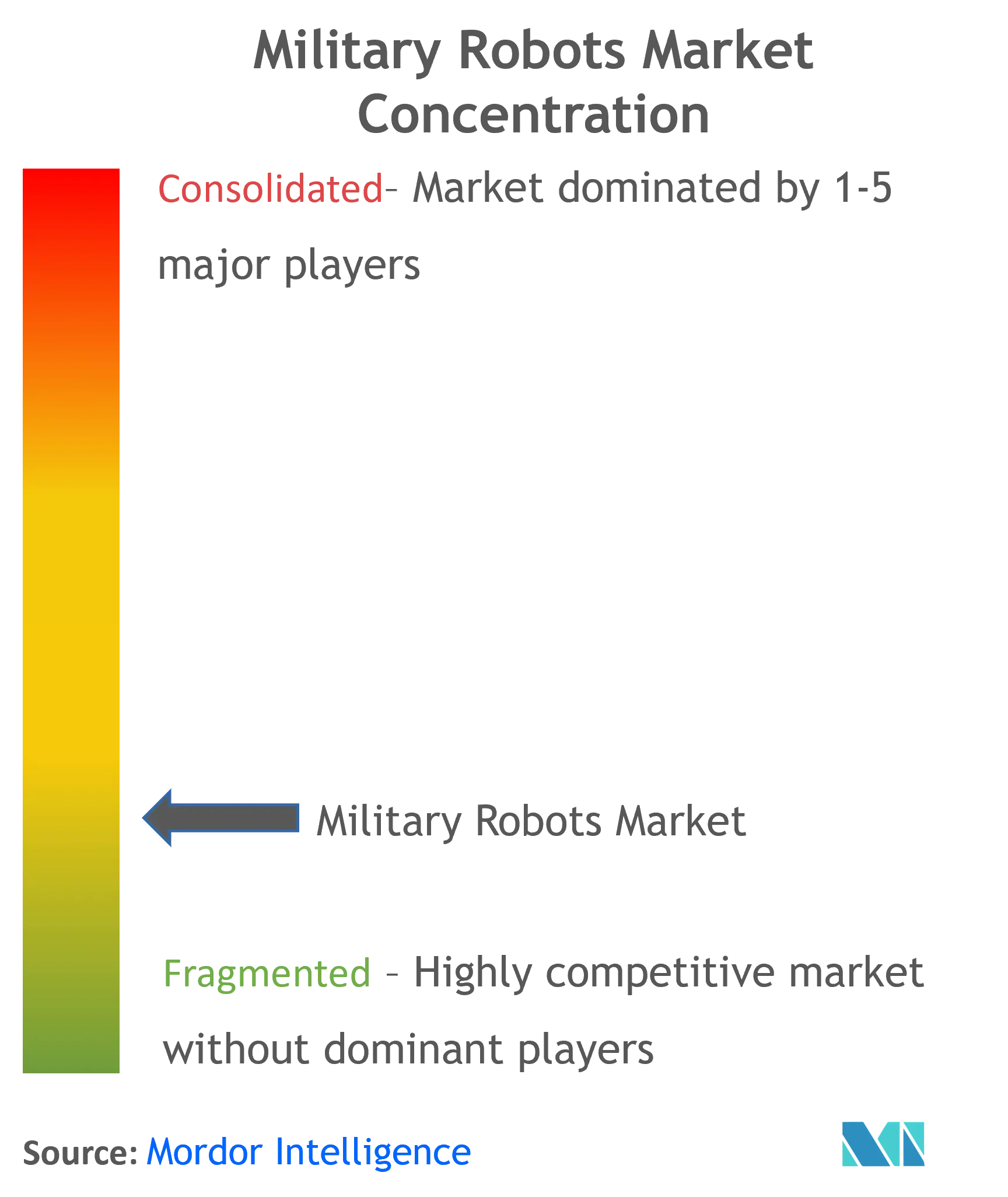
Military Robots Market News
- October 2023: The US Army is reportedly developing integrated formations of robots and human operators as part of the modernization efforts. The US Army’s Rapid Capabilities and Critical Technologies Office (RCCTO) plans to use existing science and technology as well as information from fielded programs to figure out how to combine capabilities to maximize coordination on the battlefield.
- July 2022: Teledyne FLIR Defense signed a contract worth USD 62.1 million with the US Armed Services for the procurement of 500 Centaur multi-mission robots.
- January 2022: China introduced what it claims to be the world's largest electrically powered quadruped robot to assist the military on logistics and reconnaissance missions. It is a four-legged robot that can carry up to 352 pounds of payload with a speed of 10 kilometers per hour.
Military Robots Market Report - Table of Contents
1. INTRODUCTION
- 1.1 Study Assumptions and Market Definition
- 1.2 Scope of Study
2. RESEARCH METHODOLOGY
3. EXECUTIVE SUMMARY
4. MARKET DYNAMICS
- 4.1 Market Overview
- 4.2 Market Drivers
- 4.3 Market Restraints
-
4.4 Porter's Five Forces Analysis
- 4.4.1 Bargaining Power of Buyers/Consumers
- 4.4.2 Bargaining Power of Suppliers
- 4.4.3 Threat of New Entrants
- 4.4.4 Threat of Substitute Products
- 4.4.5 Intensity of Competitive Rivalry
5. MARKET SEGMENTATION
-
5.1 Platform
- 5.1.1 Land
- 5.1.2 Marine
- 5.1.3 Airborne
-
5.2 Mode of Operation
- 5.2.1 Human Operated
- 5.2.2 Autonomous
-
5.3 Geography
- 5.3.1 North America
- 5.3.1.1 United States
- 5.3.1.2 Canada
- 5.3.2 Europe
- 5.3.2.1 United Kingdom
- 5.3.2.2 France
- 5.3.2.3 Germany
- 5.3.2.4 Russia
- 5.3.2.5 Rest of Europe
- 5.3.3 Asia-Pacific
- 5.3.3.1 China
- 5.3.3.2 India
- 5.3.3.3 Japan
- 5.3.3.4 South Korea
- 5.3.3.5 Rest of Asia-Pacific
- 5.3.4 Latin America
- 5.3.4.1 Brazil
- 5.3.4.2 Rest of Latin America
- 5.3.5 Middle-East and Africa
- 5.3.5.1 Saudi Arabia
- 5.3.5.2 United Arab Emirates
- 5.3.5.3 Israel
- 5.3.5.4 Turkey
- 5.3.5.5 Rest of Middle-East and Africa
6. COMPETITIVE LANDSCAPE
- 6.1 Vendor Market Share
-
6.2 Company Profiles
- 6.2.1 Northrop Grumman Corporation
- 6.2.2 Lockheed Martin Corporation
- 6.2.3 General Dynamics Corporation
- 6.2.4 AeroVironment Inc.
- 6.2.5 Teledyne FLIR LLC
- 6.2.6 QinetiQ Group PLC
- 6.2.7 Cobham Ltd.
- 6.2.8 Elbit Systems Ltd.
- 6.2.9 IAI
- 6.2.10 THALES
- 6.2.11 BAE Systems plc
- 6.2.12 Saab AB
- 6.2.13 Aeronautics Ltd.
- 6.2.14 BAYKAR
- 6.2.15 Textron Inc.
- *List Not Exhaustive
7. MARKET OPPORTUNITIES AND FUTURE TRENDS
** Subject To AvailablityMilitary Robots Industry Segmentation
Military robots are autonomous or remote-controlled systems designed for various military applications. The military robots contribute to the defensive superiority of the forces. They can augment human capabilities, protect soldiers from danger, or eliminate the necessity to deploy soldiers completely while also safely responding to threats of all kinds, including natural disasters.
The market is segmented into platform, mode of operation, and geography. By platform, the market is segmented into land, marine, and airborne. By mode of operation, the market is segmented into human-operated and autonomous. The report also covers the market sizes and forecasts for the military robots market in major countries across different regions. For each segment, the market size is provided in terms of value (USD).
| Platform | Land | |
| Marine | ||
| Airborne | ||
| Mode of Operation | Human Operated | |
| Autonomous | ||
| Geography | North America | United States |
| Canada | ||
| Geography | Europe | United Kingdom |
| France | ||
| Germany | ||
| Russia | ||
| Rest of Europe | ||
| Geography | Asia-Pacific | China |
| India | ||
| Japan | ||
| South Korea | ||
| Rest of Asia-Pacific | ||
| Geography | Latin America | Brazil |
| Rest of Latin America | ||
| Geography | Middle-East and Africa | Saudi Arabia |
| United Arab Emirates | ||
| Israel | ||
| Turkey | ||
| Rest of Middle-East and Africa |
Military Robots Market Research FAQs
How big is the Military Robots Market?
The Military Robots Market size is expected to reach USD 24.37 billion in 2024 and grow at a CAGR of 6.97% to reach USD 34.12 billion by 2029.
What is the current Military Robots Market size?
In 2024, the Military Robots Market size is expected to reach USD 24.37 billion.
Who are the key players in Military Robots Market?
Elbit Systems Ltd, BAE Systems plc, Northrop Grumman Corporation, Lockheed Martin Corporation and THALES are the major companies operating in the Military Robots Market.
Which is the fastest growing region in Military Robots Market?
Asia-Pacific is estimated to grow at the highest CAGR over the forecast period (2024-2029).
Which region has the biggest share in Military Robots Market?
In 2024, the North America accounts for the largest market share in Military Robots Market.
What years does this Military Robots Market cover, and what was the market size in 2023?
In 2023, the Military Robots Market size was estimated at USD 22.67 billion. The report covers the Military Robots Market historical market size for years: 2019, 2020, 2021, 2022 and 2023. The report also forecasts the Military Robots Market size for years: 2024, 2025, 2026, 2027, 2028 and 2029.
Military Robotics Systems Industry Report
Statistics for the 2024 Military Robotics Systems market share, size and revenue growth rate, created by Mordor Intelligence™ Industry Reports. Military Robotics Systems analysis includes a market forecast outlook to 2029 and historical overview. Get a sample of this industry analysis as a free report PDF download.



